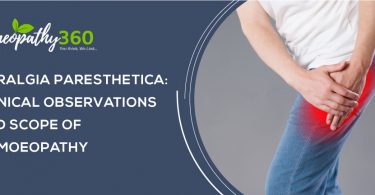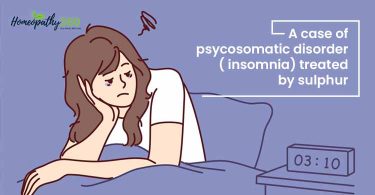Sinusitis is a condition in which the cavities around the nasal passages become inflamed. Sinusitis is one of the most common of all the respiratory infections which interferes with patients’s quality of life and loss of work productivity. The cause of sinusitis is multi factorial, anatomic, genetic and environmental which leads to various cycle of infection, swelling and blockage. With proper selection of remedy based on totality of symptoms and constitutional approach Sinusitis can be managed in homoeopathy.
Sinusitis is inflammation of the sinuses, which are air-filled cavities in the skull. The etiology can be infectious (bacterial, viral, or fungal) or noninfectious (allergic) triggers. This inflammation leads to blockage of the normal sinus drainage pathways (sinus ostia), which in turn leads to mucus retention, hypoxia, decreased mucociliary clearance, and predisposition to bacterial growth. Approximately 0.5% to 13% of viral upper respiratory tract infections progress to acute bacterial sinusitis. It is estimated that 6% to 13% of children will have one case of acute sinusitis by the age of 3 years. School-age children on average contract 6 to 8 upper respiratory tract infections per year, and of these, 5% to 10% will be complicated by sinusitis.
Sinusitis can be divided into the following categories:
- Acute sinusitis, defined as symptoms of less than 4 weeks duration.
- Subacute sinusitis, defined as symptoms of 4 to 8 weeks duration.
- Chronic sinusitis, defined as symptoms lasting longer than 8 weeks.
- Recurrent acute sinusitis, often defined as three or more episodes per year, with each episode lasting less than 2 weeks.
SIGNS AND SYMPTOMS
Acute bacterial sinusitis in adults most often manifests with more than 7 days of nasal congestion, purulent rhinorrhea, postnasal drip, and facial pain and pressure, alone or with associated referred pain to the ears and teeth. There may be a cough, often worsening at night. Children with acute sinusitis might not be able to relay a history of postnasal drainage or headaches, so cough and rhinorrhea are the most commonly reported symptoms. Other symptoms can include fever, nausea, fatigue, impairments of smell and taste, and halitosis.
Chronic sinusitis can cause more indolent symptoms that persist for months. Nasal congestion and postnasal drainage are the most common symptoms of chronic sinusitis. Chronic cough that is described as worse at night or on awakening in the morning is also a commonly described symptom of chronic sinusitis.
| Box 2: Symptoms Associated with the Diagnosis of Chronic Sinusitis |
| Facial pain or pressure |
| Facial congestion or fullness |
| Nasal obstruction or blockage |
| Nasal discharge, purulence, or postnasal drip |
| Hyposmia or anosmia |
| Headache |
| Fever |
| Halitosis |
| Fatigue |
| Dental pain |
| Cough |
| Ear pain, pressure, fullness |
DIAGNOSIS
In a primary care setting, a good history and physical examination to detect the presence of most or all of the commonly manifesting signs and symptoms can provide a reliable diagnosis of acute sinusitis. The presence of purulent secretions has the highest positive predictive value for diagnosing sinusitis clinically.
- Radiographic Evaluation
- § Transillumination
- Ultrasonography
- § Nasal Smear
- Sinus Puncture
MIASMATIC BACKGROUND
Miasmatic consideration:
Here we will have an overview of the manifestations of all the miasms in sinusitis.
PSORA:
Psora manifests the symptoms of functional disorders only. No structural change can be seen in uncomplicated psora. All the ‘sensation as if’ and characteristic symptoms especially concomitants belongs to psora.
Psora presents with morning constantly returning, persistent, usually frontal headaches. These headaches grow worse as the sun ascends and decrease as it descends. The headaches are sharp, severe paroxysmal. Usually frontal, temporal, or temporo-parietal, sometimes on vertex. Headaches, which are better by being quiet, rest or sleep.
Headaches better by hot applications. Headache from hunger.
The psoric cold begins with sneezing, redness, heat, and sensitiveness to touch when blown for some time, discharge thin, watery and acrid. Epistaxis more or less profuse or less frequent. Sensation of dryness in the nose, troublesome even when the air passes freely. Senses of smell weak, loss. Stoppage of one nose causes mouth breathing.
SYCOSIS:
Sycotic manifestations are characterized by slowness of recovery. Sycosis develops the catarrhal discharge. Pain in frontal or vertex at or after midnight.
Headaches of sycotic children are more common and are worse at night, producing feverishness, restlessness, crying, fretting and worrying. Better by motion. Headaches worse lying down and at night, especially after midnight. The patient is restless and wants to be kept in motion, which ameliorates. Headache worse riding, exertion either mental or physical. Headache usually accompanied by sadness and prostration.
There is loss of smell. Nose clear one hour, the next he cannot get a particle of air through his nasal passages. A red nose with enlarged capillaries.
Snuffles in children. This is usually moist and there is no ulceration and no crusts, or if purulent, is very scanty and has the odor of fish brine or stale fish. The stoppage is due to local congestion and thickening of the membrane or enlargement of the turbinate due
to congestion. The discharge is yellowish green, scanty or copious, thin mucous. Children from sycotic parents complicated with gout, take cold easily at slightest exposure and frequently suffer from acute coryza. Discharge from nose becomes copious, watery and often excoriating. The slightest amount of discharge ameliorates.
SYPHILIS:
Headaches worse at night. They improve in the morning and remain better all day until evening when they grow worse as the night advances. Dull, heavy or lancinating, constant, persistent headaches. Usually basilar or linear or one-sided. Headaches worse warmth, rest or while attempting to sleep. Headache worse on lying down. Loss of smell. Snuffles in children, ulceration, thick crusts often filling whole nasal cavity. The crusts are dark, greenish black or brown, thick and not always offensive. Bones of nose destroyed. Deposition of crusts in nose with offensive breath.
TUBERCULAR:
Headache occurring every sunday or on rest days, worse riding in carriages or are due to the least unusual ordeal, as preparing for examinations; meeting with strangers and entertaining them. Headache with deathly coldness of hands and feet, with prostration, sadness and general despondency.
Headache with red face and rush of blood to head, or at certain hours of the day. Usually in the forenoon; headaches better by rest, quiet, sleep, eating, nose bleed.
REMEDIES:
Silicea – Best homeopathic medicine for sinusitis when cold aggravates the sinusitis.
There is an increased sensitivity to cold and the patient lacks in natural warmth of the body. Slightest exposure to cold air or temperature can create havoc with the system of the patient. Patient feels much better in warmth, a warm room or warm weather and therefore tends to wrap himself in warm clothes or blanket. This increased sensitivity to cold is often manifested as a recurrent cold or inflammation of the sinuses. The discharges are often yellowish or greenish yellow and is more suited to the chronic sinusitis. Sneezing in the morning is a common occurrence.There may be pain in the head or the forehead region and is often felt in the right eye too.
Kali Bichromicum – the most common homeopathic medicine for chronic sinusitis.
It is very effective in the treatment of chronic sinusitis. It affects the mucous membranes everywhere, more so of the respiratory system and causes inflammation of the membranes. The main distinguishing feature of this homeopathic medicine is that the discharge from the nose is thick, ropy and stringy in character. The mucous is thick and yellowish or greenish yellow in colour. The symptoms are aggravated in the morning. There is stuffiness of the nose and the nose feels blocked, making it difficult to breathe through the nose. There may be bad smell in the nose. Violent sneezing may be present.
Hydrastis – one of the best homeopathic remedies for acute sinusitis as well as chronic sinusitis.
The discharge may be thin and watery as happens in acute sinusitis or thick, yellowish and tenacious when the sinusitis is chronic in nature. There may be bad odor from the nose. There is persistent post nasal discharge, which is again thick and yellowish in colour. There may be dull pain in the frontal region. The patient feels like blowing his nose all the time as the nose seems blocked. At times, patient feels a sense of tickling in the nose, as that of a hair. It causes a lot of weakness in the patient and is therefore quite well suited to tired, weak and lethargic patients.
Pulsatilla– the homeopathic medicine for chronic sinusitis with green discharge.
This patient often feels better in open air and is aggravated in a closed place like a room or a crowded place. Tolerating heat and the summer weather is difficult for the patient. The mental symptom of crying at the slightest reason is a predominant guiding feature of this homeopathic remedy. The discharge from the nose is often greenish or yellowish green. The patient feels thirstless and hardly feels like drinking water. There is pain in the head which is better by lying down or binding the head tightly. The right nostril feels stopped, more so in the evening and there is heaviness or pressing pain at the root of the nose. Sensation of smell is often lost.
Hepar Sulphur– homeopathic remedy for sinusitis and to reduce sensitivity.
It is an excellent homeopathic medicine to stop the sensitivity of the patient to cold temperature and cold weather. The slightest exposure to cold in any form tends to bring on the symptoms of sneezing and running nose. The nose may get blocked up on slightest exposure to cold air or cold temperature. Cough starts on the slightest exposure.The patient is physically as well as mentally sensitive. Pus like discharge from the nose may be present. A smell like old cheese may persist in the nose. The discharge is watery in the case of acute sinusitis while it is thick and greenish in the case of chronic sinusitis.
Mercurius Solubilis– A person needing this homeopathic remedy often experiences much sneezing with a fluent and often acrid discharge from the nose. Some portion of the mucus may trickle down post-nasally into the throat causing hawking, hoarseness and a dry, rough cough from continual tickling in the throat. The acrid discharge from the nose (which may at times take on a greenish hue) can smell like old cheese. There are often pressing and/or tearing pains in the forehead, cheeks, upper teeth, and ears. If there is a headache, there is also much congestion to the head with the head feeling as if it would burst or as if it is in a vise. The patient is thirsty even though the mouth is quite moist. The breath will often be very offensive during the illness. Typically someone needing this remedy feels worse in damp weather, at night and from either cold or warm air. They may also feel a bit restless during the ailment.
Phosphorus– Someone needing this homoeopathic remedy often complains of having a stuffed nose one moment and fluent nasal discharges the next. These symptoms often come with a feeling of dullness in the head and a sore throat. Hoarseness often follows. The mucus from the nose is typically profuse, greenish, yellow and blood- streaked. In fact, there is frequently blood in the mucus on blowing the nose. Your patient may complain that their smell and taste are gone. There will frequently be a dull pain in the forehead to the root of the nose and to the upper eyelids, with a feeling of pressure extending into eyes or a pressive headache above the eyes. Someone needing Phosphorus is always thirsty for cold drinks during their illness.
Arsenicum Album: People who need this remedy feel throbbing and burning pains in the sinuses. Their pains are aggravated by light, noise, movement, after midnight, and may be triggered by anxiety, exertion, and excitability. They may feel relief by lying quietly in a dark room with the head raised on pillows and exposed to cool air. Their teeth may feel long and painful. They may feel nausea and experience vomiting concurrent with their sinusitis. They tend to have a great thirst, but they tend to drink frequent sips, rather than gulps.
Belladonna (deadly nightshade): This remedy is effective for people whose head feels full, as if it could burst. The pain usually resides in the forehead or around the eyes.
There is throbbing pain that is worse by jarring, touch, bending forward, lying flat, or motion of the eyes and is relieved by gradually applied pressure, sitting up, or bending the head backwards. Another characteristic symptoms of people who need this remedy is when the sinus pain appear strongly and rapidly but then disappears temporarily, only to repeat the process of coming and going pain. The eyes are also sensitive to light and the face is flushed. They are apt to feel dizzy which becomes worse when stooping.
Spigelia Anthelmia- People who develop sinusitis with a sharp pain that is worse on the left side may need this medicine. They tend to get sinusitis after exposure to cold or cold, wet weather. They feel pain from warmth or when they stoop or bend the head forward, and they feel some relief by cold applications or from washing with cold water.
Natrum Mur And Sabadilla- Homeopathic Remedies for Sinus Infections accompanied with sneezing. Natrum mur and Sabadilla assumes the top rank among natural Homeopathic remedies for sinus Infections when sneezing accompanies sinus inflammation. Along with sneezing, a fluent discharge of nose with headache is indicative of the both the homeopathic remedies for sinus infections.
CONCLUSION:
There
are many more remedies for sinusitis in homoeopathy. With the selection of
similar remedy based on totality of symptoms can successfully manage the case.
List of references:
- Chaturbhuja Nayak, Vikram Singh, VP Singh, Praveen Oberai, Varanasi Roi, MN Sinha, et al. Homeopathy in chronic sinusitis, A prospective multi-centric observational study. CCRH:2012 February;101,84-91.(cited on 06/02/2012)Available from https://www.researchgate.net/publication/223968995_Homeopathy_in_chronic_sinusitis_A_prospective_multi-centric_observational_study/link/5cb07de992851c8d22e58c85/download
- Boericke W, Pocket Manual of Homoeopathic Materia Medica & Repertoty.9ed: B.Jain Publishers,New Delhi,2013 (p)Ltd.552-556
- Robin Murphy, ND, Homoeopathic Medical Repertory by Robin Murphy, 2nd revised edition, B.Jain Publishers, New Delhi,1993
- Sarkar BK , Hahnemann’s organon of medicine,9ed.Birla publications,New Delhi2003:421-439.
- Jameson, Fauci, Kasper, Hauser, Longo, Loscalzo. Harrison’s- principle of internal medicine. 20th edition: McGraw Hill Education; (1 January 2018).
About Author:
Dr S.R.Sushmitha
Md Part 2
Department Of Practice Of Medicine
Government Homoeopathic Medical College And Hospital Bangalore





